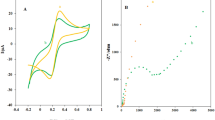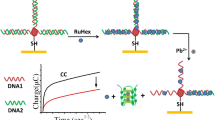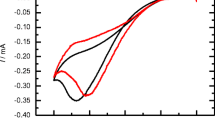Abstract
An electrochemical DNA biosensor based on a G-quadruplex (G4) for the sensitive determination of Pb2+ was reported using a carbon paste electrode (CPE) or a multi-walled carbon nanotube paste electrode (MWCNTPE) as working electrodes, ethyl green (EG) as a new G4 intercalator, and a single-stranded nucleic acid sequence rich in guanine (G) as DNA probe. Electrochemical determination of Pb2+ relied on probe structural changes from single - stranded to the stabilized intramolecular G4 in the presence of Pb2+, which caused a change in the current of the EG reduction peak due to the intercalation of EG into the G4 structure. The change in the reduction peak of EG before and after its intercalation into the stabilized G4 (∆I) had a linear correlation to the concentration of Pb2+ ions. The linear ranges of 4.0 × 10−10–5.0 × 10−9 M and 2 × 10−7–1 × 1−5 M with a detection limit (LOD) of 1.04 × 10−10 M were obtained using CPE, while improved linear ranges of 4.0 × 10−11–1.0 × 10−9 M and 2 × 10−7–1 × 10−5 M with a lower LOD of 2.64 × 10−11 M were achieved using the MWCNTPE biosensor. The biosensors exhibited satisfactory results in terms of selectivity and practical applicability in the analysis of real samples.

The principle of the electrochemical sensing of Pb2+ based on intramolecular G-quadruplex using EG.








Similar content being viewed by others
References
Lin Z, Chen Y, Xi L, Fang W. Pb2+ induced DNA conformational switch from hairpin to G-quadruplex: electrochemical detection of Pb2+. Analyst. 2011;136:2367–72.
Bala A, Pietrzak M, G’orski Ł, Malinowska E. Electrochemical determination of lead ion with DNA oligonucleotide-based biosensor using anionic redox marker. Electrochim Acta. 2015;180:763–9.
Jarczewska M, Kierzkowska E, Zilkowski R, G’orski Ł, Malinowska E. Electrochemical oligonucleotide-based biosensor for the determination of lead ion. Bioelectrochemistry. 2015;101:35–41.
Li F, Feng Y, Zhao C, Tang B. Crystal violet as a G-quadruplex-selective probe for sensitive amperometric sensing of lead. Chem Commun. 2011;47:11909–11.
Yang C, Liu L, Zeng T, Yang D, Yao Z, Zhao Y, et al. Highly sensitive simultaneous detection of lead(II) and barium(II) with G-quadruplex DNA in α-hemolysin nanopore. Anal Chem. 2013;85:7302–7.
Abdollahi M, Sadeghi Mojarad A, Jalali N. Lead toxicity in employees of a paint factory. MJIRI. 1996;10:203–6.
Mohammadi S, Mehrparvar A, Aghilinejad M. Appendectomy due to lead poisoning: a case-report. J Occup Med Toxicol. 2008;17:23–8.
Karimooy HN, Mood MB, Hosseini M, Shadmanfar S. Effects of occupational lead exposure on renal and nervous system of workers of traditional tile factories in Mashhad (northeast of Iran). Toxicol Ind Health. 2010;26:633–8.
Karrari P, Mehrpour O, Abdollahi M. A systematic review on status of lead pollution and toxicity in Iran; guidance for preventive measures. DARU J Pharma Sci. 2012;20:2–18.
Boon Teh H, Li H, Li SFY. Highly sensitive and selective detection of Pb2+ ions using a novel and simple DNAzyme-based quartz crystal microbalance with dissipation biosensor. Analyst. 2014;139:5170–5.
Zhang N, Peng H, Wang Sh HB. Fast and selective magnetic solid phase extraction of trace Cd, Mn and Pb in environmental and biological samples and their determination by ICP-MS. Microchim Acta. 2011;17:121–8.
Frazzoli C, Bocca B. Validation, uncertainty estimation and application of a sector field ICP MS-based method for As, Cd and Pb in cow’s milk and infant formulas. Microchim Acta. 2008;162:43–50.
Behbahani M, Abandansari HS, Salarian M, Babapour M, Bagheri A, Nabid MR. Synthesis and application of a thermo sensitive tri-block copolymer as an efficient sample treatment technique for preconcentration and ultra-trace detection of lead ions. Microchim Acta. 2014;181:129–37.
Liu Y, Liu Z, Wang Y, Dai J, Gao J, Xie J, et al. A surface ion-imprinted mesoporous sorbent for separation and determination of Pb (II) ion by flame atomic absorption spectrometry. Microchim Acta. 2011;172:309–17.
Tassali N, Kotera N, Boutin C, Leonce E, Boulard Y, Rousseau B, et al. Smart detection of toxic metal ions, Pb2+ and Cd2+, using a Xe-129 NMR-based sensor. Anal Chem. 2014;86:1783–8.
Liu SY, Na WD, Pang S, Su XG. Fluorescence detection of Pb2+ based on the DNA sequence functionalized CdS quantum dots. Biosens Bioelectron. 2014;58:17–21.
Songsungkan J, Chanthai S. Study of allicin extract chelated with some heavy metals (Cu2+, Co2+ and Pb2+) by fluorescence quenching method and its antioxidant activity. Asian J Chem. 2014;26:132–6.
Liu L, Lin HW. Paper-based colorimetric array test strip for selective and semiquantitative multi-ion analysis: simultaneous detection of Hg2+, Ag+, and Cu2+. Anal Chem. 2014;86:8829–34.
Hung YL, Hsiung TM, Chen YY, Huang YF, Huang CC. Colorimetric detection of heavy metal ions using label-free gold nanoparticles and alkanethiols. J Phys Chem C. 2010;114:16329–34.
Harrington CF, Clough R, Drennan-Harris LR, Hill SJ, Tyson JF. Atomic spectrometry update. Elemental speciation. J Anal At Spectrom. 2011;26:1561–95.
Wang J. Electrochemical nucleic acid biosensors. Anal Chim Acta. 2002;469:63–71.
March G, Dung Nguyen T, Piro B. Modified electrodes used for electrochemical detection of metal ions in environmental analysis. Biosensors. 2015;5:241–75.
Ebrahimi M, Raoof JB, Ojani R. Novel electrochemical DNA hybridization biosensors for selective determination of silver ions. Talanta. 2015;144:619–26.
Ebrahimi M, Raoof JB, Ojani R, Bagheryan Z. A novel electrochemical biosensor for selective determination of mercury ions based on DNA hybridization. Anal Biochem. 2015;488:13–4.
Cui L, Wu J, Ju H. Electrochemical sensing of heavy metal ions with inorganic, organic and bio-materials. Biosens Bioelectron. 2015;63:276–86.
Li LD, Huang XQ, Guo L. Electrochemical potassium ion sensor based on DNA G-quadruplex conformation and gold nanoparticle amplification. Rare Metals. 2013;32:369–74.
Burge S, Parkinson GN, Hazel P, Todd AK, Neidle S. Survey and summary, quadruplex DNA: sequence, topology and structure. Nuc Acids Res. 2006;34:5402–15.
Ruttkay-Nedecky B, Kudr J, Nejdl L, Maskova D, Kizek R, Adam V. G-Quadruplexes as sensing probes. Molecules. 2013;18:14760–79.
Chiorcea-Paquim AM, Oliveira-Brett AM. Redox behaviour of G-quadruplexes. Electrochim Acta. 2014;126:162–70.
Bagheryan Z, Raoof JB, Ojani R, Hamidi-Asl E. Introduction of ketamine as a G-Quadroplex binding ligand using platinum nanoparticle modified carbon paste electrode. Electroanalysis. 2013;25:2659–67.
Kong DM, Ma YE, Wu J, Shen HX. Discrimination of G-Quadruplex from duplex and single-stranded DNAs with fluorescence and energy-transfer fluorescence spectra of Crystal Violet. Chemistry. 2009;15:901–9.
Bhasikuttan AC, Mohanty J, Pal H. Interaction of malachite green with guanine-rich single-stranded DNA: preferential binding to a G-quadruplex. Angew Chem Int Ed. 2007;46:9305–7.
Ge C, Liao J, Yu W, Gu N. Electric potential control of DNA immobilization on gold electrode. Biosens Bioelectron. 2003;18:53–8.
Lao R, Song Sh WH, Wang L, Zhang Z, He L, Fan C. Electrochemical interrogation of DNA monolayers on gold surfaces. Anal Chem. 2005;77:6475–80.
Lucarelli F, Marrazza G, Turner APF, Mascini M. Carbon and gold electrodes as electrochemical transducers for DNA hybridisation sensors. Biosens Bioelectron. 2004;19:515–30.
Wang J, Cai X, Rivas G, Shiraishi H, Farias PAM, Dontha N. DNA electrochemical biosensor for the de-tection of short DNA sequences related to the human immunodeficiency virus. Anal Chem. 1996;68:2629–34.
Pournaghi-Azar MH, Hejazia MS, Alipour E. Developing an electrochemical deoxyribonucleic acid (DNA) biosensor on the basis of human interleukine-2 gene using an electroactive label. Anal Chim Acta. 2006;570:144–50.
Pang DW, Abruna HD. Micromethod for the investiga-tion of the interactions between DNA and redox-active molecules. Anal Chem. 1998;70:3162–9.
Oliveira Brett AM, Macedo TRA, Raimundo D, Marques MH, Serrano SHP. Voltammetric behaviour of mitox-antrone at a DNA-biosensor. Biosens Bioelectron. 1998;13:861–7.
Sun X, He P, Liu S, Ye L, Fang Y. Immobilization of single-stranded deoxyribonucleic acid on gold electrode with self-assembled aminoethanethiol monolayer for DNA electro-chemical sensor applications. Talanta. 1998;47:487–95.
Cao RG, Zhu B, Li J, Xu D. Oligonucleotides-based biosensors with high sensitivity and selectivity for mercury using electrochemical impedance spectroscopy. Electrochem Commun. 2009;11:1815–8.
Livache T, Fouque B, Roget A, Marchand J, Bidan G, Téoule R, et al. Polypyrrole DNA chip on a silicon device: example of hepatitis C virus genotyping. Anal Biochem. 1998;255:188–94.
Peng H, Zhang L, Soeller C, Travas-Sejdic J. Conducting polymers for electrochemical DNA sensing. Biomaterials. 2009;30:2132–48.
Bonanni A, Pividori MI, Valle MD. Application of the avidin-biotin interaction to immobilize DNA in the development of electrochemical impedance genosensors. Anal Bioanal Chem. 2007;389:851–61.
Millan KM, Spurmanis AL, Mikkelsen SK. Covalent immobilization of DNA onto glassy carbon electrodes. Electroanalysis. 1992;4:929–32.
Ligaj M, Jasnowska J, Musiał WG, Filipiak M. Covalent attachment of single-stranded DNA to carbon paste electrode modified by activated carboxyl groups. Electrochim Acta. 2006;51:5193–8.
Pividori MI, Alegret S. DNA adsorption on carbonaceous materials. Top Curr Chem. 2005;260:1–36.
Pividori MI. Merkoc¸i a, Alegret S. DNA immobilization. Electrochemical genosensor design: immobilisation of oligonucleotides onto transducer surfaces and detection methods. Biosens Bioelectron. 2000;15:291–303.
Mazloum-Ardakani M, Mandegari AA, Masoum S, Naeimi H. Multiwall carbon nanotubes modified carbon paste electrode for determination of copper(II) by potentiometric and impedimetric methods. JNS. 2012;2:333–43.
He P, Xu Y, Fang Y. A review: electrochemical DNA biosensors for sequence recognition. Anal Let. 2005;38:2597–623.
Elrouby M. Electrochemical application of carbon nanotube. J Nano Adv Mat. 2013;1:23–38.
Reid Bishop G, Chaires JB. Characterization of DNA structures by circular dichroism. Curr Protoc Nucleic Acid Chem. 2002; 7.11.1–7.11.8.
Porumb H, Monnot M, Fermandjian S. Circular dichroism signatures of features simultaneously present in structured guanine-rich oligonucleotides: a combined spectroscopic and electrophoretic approach. Electrophoresis. 2002;23:1013–20.
Chen J, Zhang J, Zhuang Q, Chen J, Lin X. Electrochemical studies of the interaction of 2-Nitroacridone with DNA and determination of DNA. Electroanalysis. 2007;19:1765–72.
Wang Q, Wang X, Yu Z, Yuan X, Jiao K. Spectroscopic and electrochemical studies on the binding mechanism of DNA With An Anthraquinone Biological Dye, Nuclear Fast Red. Int J Electrochem Sci. 2011;6:5470–81.
Wang QX, Jiao K, Liu FQ, Yuan XL, Sun W. Spectroscopic, viscositic and electrochemical studies of DNA interaction with a novel mixed-ligand complex of nickel (II) that incorporates 1-methylimidazole and thiocyanate groups. J Biochem Biophys Methods. 2007;70:427–33.
Barton JK, Danishefsky AT, Goldberg JM. Tris (phenanthroline) ruthenium(II): stereoselectivity in binding to DNA. J Am Chem Soc. 1984;106:2172–6.
Long EC, Barton JK. Demonstrating DNA intercalation. Acc Chem Res. 1990;23:271–3.
Ramakrishnan S, Palaniandavar M. Mixed-ligand copper (II) complexes of dipicolylamine and 1, 10-phenanthrolines: the role of diimines in the interaction of the complexes with DNA. J Chem Sci. 2005;117:179–86.
Wang XL, Fang JN, Bi YF, Lin HY, Liu GC. Synthesis, DNA-binding, and photocleavage of 2,3-di-2-pyridylquinoxaline-silver(I) complex. Chem Res Chin Univ. 2008;24:15–9.
Carter MT, Rodriguez M, Bard AJ. Voltammetric studies of the interaction of metal-chelates with DNA .2. Tris-chelated complexes of cobalt (III) and iron (II) with 1,10-phenanthroline and 2,2′-bipyridine. J Am Chem Soc. 1989;111:8901–11.
Author information
Authors and Affiliations
Corresponding author
Ethics declarations
Conflict of interest
The authors declare that they have no conflict of interest.
Human and animal rights
This work does not contain any studies with human participants or animals.
Rights and permissions
About this article
Cite this article
Ebrahimi, M., Raoof, J.B. & Ojani, R. Design of a novel electrochemical biosensor based on intramolecular G-quadruplex DNA for selective determination of lead(II) ions. Anal Bioanal Chem 409, 4729–4739 (2017). https://doi.org/10.1007/s00216-017-0416-5
Received:
Revised:
Accepted:
Published:
Issue Date:
DOI: https://doi.org/10.1007/s00216-017-0416-5




